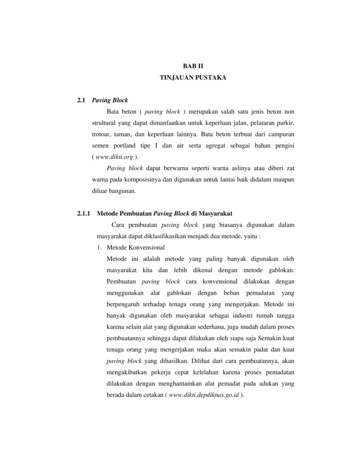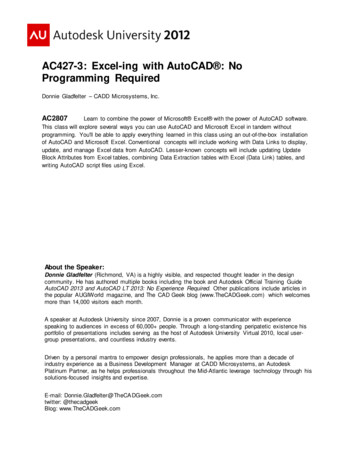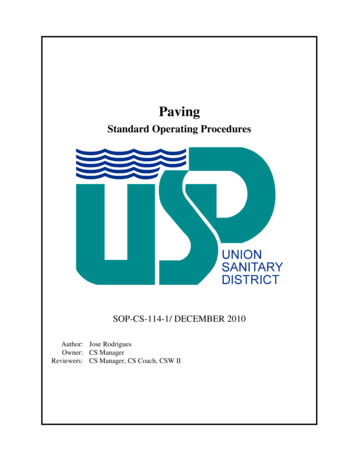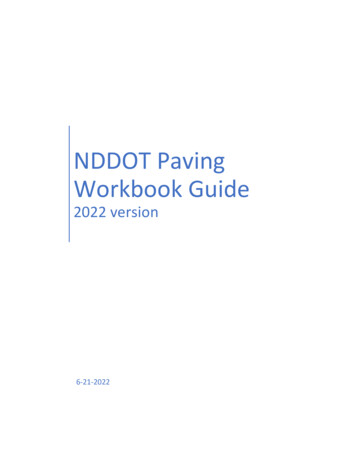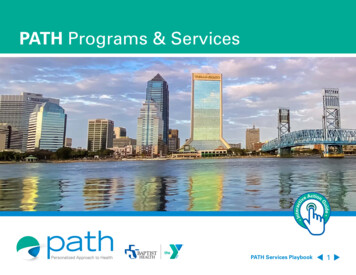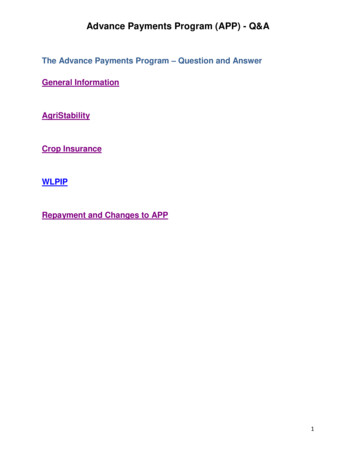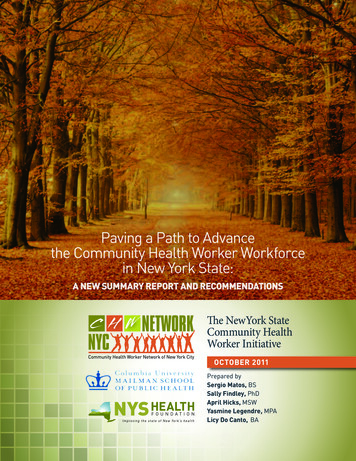
Transcription
Paving a Path to Advancethe Community Health Worker Workforcein New York State:A New Summary Report and RecommendationsNYCNETWORKCommunity Health Worker Network of New York CityThe NewYork StateCommunity HealthWorker InitiativeOctober 2011Prepared bySergio Matos, BSSally Findley, PhDApril Hicks, MSWYasmine Legendre, MPALicy Do Canto, BA
Leadership Advisory Group: Organizations1199 SEIU United HealthcareWorkers EastAmerican Cancer SocietyArthur Ashe InstituteBronx-Lebanon Hospital CenterBuilding Bridges, BuildingKnowledge, Building HealthCoalitionHealth PlusHealthcare Association ofNew York State (HANYS)Korean Community Servicesof Metropolitan New YorkLittle Sisters of the AssumptionLivestrong, Lance ArmstrongFoundationBusiness and Labor Coalitionof New YorkManhattan-Staten Island AreaHealth Education CenterColumbia University MailmanSchool of Public HealthNassau County Departmentof HealthCommunity Health WorkerNetwork of BuffaloNational Council on AgingCity University of New York(CUNY)Community Health CareAssociation of New York State(CHCANYS)Community Health Foundationof Western and Central New YorkCommunity Health WorkerAssociation of RochesterCommunity Health WorkerNetwork of NYCCommunity Healthcare NetworkCommunity Resources, LLCCommunity Service Societyof New YorkCommunity Voices, MorehouseSchool of MedicineCornell Family DevelopmentTraining and CredentialingProgramNew York City Department ofHealth & Mental HygieneNew York Health PlanAssociationNew York Immigration CoalitionNew York State Associationof County Health Officials(NYSACHO)New York State Department ofHealth, Bureau of CommunityChronic Disease PreventionNew York State Departmentof Health, Bureau of Women’sHealth Perinatal UnitNew York State Departmentof Health, Diabetes Preventionand Control ProgramNortheast Business Groupon HealthNorthern Manhattan AsthmaBasics for ChildrenNorthern Manhattan PerinatalPartnershipNorthwest BuffaloCommunity CenterNYU Center for the Study ofAsian American HealthNYU Langone Medical CenterOffice of the Deputy Mayor forHealth and Human ServicesP2 Collaborative of WesternNew YorkParaprofessional HealthInstitute (PHI)Partnership for New York CityRalph Lauren Center for CancerCare and PreventionSouth Central CollegeTeens PACT (Positive Actionsand Choices for Teens)Greater New York HospitalAssociationThe Office of AssemblymemberRichard GottfriedThe University at BuffaloUnited Hospital FundNew York State Department ofHealth, Division of Family HealthAlliance of New York StateYMCAs, Inc.Group MinistriesThe New York State Community Health Worker Initiative
Copyrights“Paving a Path to Advance the Community Health Worker Workforce in New York State: A NewSummary Report and Recommendations”This report was produced by the Community Health Worker Network of NYC, in partnership withthe New York State Health Foundation and the Columbia University Mailman School of Public Health.The report and recommendations build and expand on the work of the New York State CommunityHealth Worker Initiative and the Leadership Advisory Group of New York health care leaders. TheInitiative, launched in 2010, created this advisory group that provided counsel in this work. The Community Health Worker Network of NYC, the New York State Health Foundation and theColumbia University Mailman School of Public HealthThe opinions and recommendations expressed in this report are those of its authors and editors,and other individuals who contributed to its creation. These views should not be construed asrepresenting the official policies of all organizations contributing to the development and publicationof this report and recommendations.General permission to reproduce and/or republish all or part of the material in this report is granted,provided that the material is reproduced unaltered and clear reference is made to this publication.Electronic copies of this report are available online at: www.chwnetwork.orgThe New York State Community Health Worker InitiativeNYCNETWORKCommunity Health Worker Network of New York CityThe Community Health Worker Network of NYC is an independent professional association of community health workers (CHWs).The Network unites CHWs to share experiences and resources, inform policy issues, and guide the development of our field.The Mailman School Mission: Dedication to knowledge creation and teaching, with an unrivaled commitment toservice at a local, national, and global level, and the translation of science for impact.The New York State Health Foundation (NYSHealth) is a private, statewide foundation that aims to improveNew York’s health care system by expanding health insurance coverage, containing health care costs, increasing accessto high-quality services, and addressing public and community health.The New York State Community Health Worker Initiative
AcknowledgementsThis report and the New York State Community Health Worker Initiative were funded by theNew York State Health Foundation and the W.K. Kellogg Foundation. A special thanks toJames R. Knickman, President and CEO, and Jacqueline Martinez, Senior Program Director,of the New York State Health Foundation; and Jocelyn Sargent, Program Officer, of the W.K. KelloggFoundation, for their support of this Initiative.The Initiative partners would like to extend a special thanks to the Leadership Advisory Group (LAG)of the New York State Community Health Worker Initiative. This group of community health workers,health care leaders, policy makers, and representatives from the public and non-profit sectors fromacross the state provided invaluable guidance and support to the success of this work. We would alsolike to extend a very special thanks to members of the LAG that gave significant contributions of theirtime and expertise to participating in the Initiative’s Work Groups, which allowed for the creation ofthe recommendations published in this report.The production of this summary report and the success of this Initiative has required special effortand expertise. We would like to thank the Do Canto and Raben Groups for their tireless efforts andwealth of knowledge in supporting and guiding us during this Initiative.Licy Do CantoDonald GatlinCharu GuptaRobert RabenHaley GriffinJonathan KentJamal SimmonsA special thanks to the Community Health Worker Association of Rochester (CHWAR) for joiningus in this effort to unite CHW voices across the state while supporting the philosophy of CHW selfdetermination so that this workforce may maintain its tradition and history.We would like to acknowledge the contributions made by Andres Nieto, Patricia Peretz, and EmilioCarrillo of New York-Presbyterian Hospital; John Sparks of Lowndes County Partnership for Health;and Barbara Barrett of Langdale Industries. Their knowledge and experience allowed for us to furtherbuild the business case for CHWs highlighted in this summary report.Lastly, we would like to recognize that the success of this Initiative and the creation of this reportwould not have been possible without the contributions of community health workers, theiremployers, and advocates from across the State. We honor you and thank you.The New York State Community Health Worker Initiative
ContentsExecutive Summary1Introduction3Background3CHW Business Case4The New York State CHW Initiative5RECOMMENDATIONS6CHW Scope of Practice6Work Group6CHW Scope of Practice Roles and Related Tasks8Recommendations9CHW Training and Credentialing10Work Group10Recommendations11CHW Financing12Work Group12Considerations13Recommendations14Appendix A16REFERENCES17
Message from the Initiative DirectorOctober 25, 2011Three years ago, I met with two dear friends and colleagues over breakfast while attendingthe annual conference of the American Public Health Association, which was held inSan Diego that year. We reminisced about the many years we had strived to promotecommunity health workers by mounting CHWs programs, building evidence that showedthe effectiveness of CHW-based interventions, organizing CHWs into a professional association,and developing appropriate training programs for CHWs. Maybe it was the coffee, or maybe thewarm southern California air, but soon we were dreaming about what more we could do if we couldjust get a little money to get going. One of my friends at the table pulled out a pen and started writingdown our thoughts and ideas on a napkin. We quickly focused on how unstable financing for CHWswas, and how this kept so many in the profession from realizing opportunity and potential. Thatbreakfast meeting amongst three friends, where we shared food, company and passion, along withthe napkin, was the beginning of the NYS Community Health Worker Initiative.The NYS Community Health Worker Initiative was formed to advance the CHW workforce. Although weunderstood very early on that our activities would be focused on financing, we also believed deeply inthe need for CHW voices from across the state to inform the process. In fact, we have always held aguiding principle of self-determination for CHWs in order to preserve the history, traditions and dignityof the work. We set about contacting and visiting different areas of the state in search of CHWs andCHW groups who were also interested in building a statewide association of CHWs. We were met withenthusiasm from CHWs everywhere we went. This was an energy that we clung to throughout thisprocess, as it wasn’t always free of conflict. Along the way, we encountered some varying perspectiveson how this path for advancing the CHW workforce should look. Some differences were very obviousand therefore easy to identify and reject in order to protect and preserve the CHW identity. Somedifferences were more nuanced and highly difficult to discern. Yet out of these difficulties an importantlesson was learned that not only reinforced our understanding of the critical importance of CHWleadership but also led to redoubling our commitment to CHW self-determination. We are thankful forthe continuous leadership and support from CHWs across the state that made this possible. We alsoreceived this support and had great success in re-establishing relationships with colleagues who builtthe Community Health Worker Association of Rochester and have now partnered with the CommunityHealth Worker Network of NYC to launch a statewide CHW association in New York.The New York State Community Health Worker Initiative
To continue in this process, we sought participation from private, non-profit, and governmentstakeholders. We were continuously energized by their excitement and support and they formedour Leadership Advisory Group (LAG), along with the CHW leaders identified earlier. The LAG hasoffered their knowledge, wisdom, and experience to guide this effort in identifying and makingrecommendations on a scope of practice, training and credentialing standards, and stable financingmodels for CHWs. The products this LAG has created through its work groups and the process theyapplied has been called perhaps the most contemporary, comprehensive, and sophisticated treatmentof this issue to date anywhere in the US.We have been busy these past three years. But on those rare occasions when we are able to stopand reflect, when we are able to realize what has been created and what we have accomplished,we are amazed to have so far exceeded our expectations. Truth be told, at those times I am oftenbrought to tears, marveling at the opportunity we have been given to advance the CHW workforcewith the dignity and respect it deserves – grateful to contribute to supporting CHWs in their heroicwork for health and social justice. Of course, none of this could have been achieved without thetireless efforts of my coworkers and others who gave so much of themselves to this work.As we move forward to implement our recommendations and continue to advance the CHWworkforce, we expect that the statewide CHW association and the LAG will continue to guide thedevelopment and maturation of the CHW workforce. We fully expect that this work will pave a pathto advancing the CHW workforce in New York and position our state as a leader in the reformationof health and advancement of justice and equality.We do not have that old napkin anymore, but the thoughts, dreams, and hopes it once held burnbright in the souls of those three friends and in the hearts of everyone they touch.Sergio Matos, DirectorNYS Community Health Worker InitiativeThe New York State Community Health Worker Initiative
Executive SummaryHealth care reform as dictated by the Patient Protection and Affordable Care Act (PPACA)is now underway. States are receiving millions of dollars from the U.S. Treasuryto create new programs and enhance old ones. The stakes are high – lowering thelong term costs of health care delivery and making health care more accessible andaffordable for millions of uninsured or underinsured Americans.As these reforms unfold, the New York State Community Health Worker Initiative has researchedthe role of community health workers (CHWs) and identified how to advance this workforcethrough state-level recommendations on employment and practice, training and certification,and financing. If these recommendations are implemented, New York stands to become a leader incutting edge programs and interventions.Studies show that CHWs improve health outcomes, particularly for low-income populations, whenthey are utilized in disease prevention and chronic disease management models, such as control ofasthma, diabetes, cardiovascular disease, and depression. Health care costs, such as emergencyroom visits and hospitalizations, go down when CHWs are involved, and patients and communitiesbetter understand their responsibilities and health care options.At New York-Presbyterian Hospital, CHWs working to control asthma reduced emergency roomvisits and hospitalizations by 50 percent and are now a permanent part of the hospital’s communityhospital partnership childhood asthma program.The Initiative’s Summary Report, “Paving a Path to Advance the Community Health Worker Workforcein New York State,” and its Recommendations are vital if New York is to succeed overall in reducinghealth care costs and improving health care delivery.What’s at StakeThe PPACA directly includes CHWs as health professionals and members of health care teamsdelivering and improving care. This puts New York at a critical juncture. State officials are in themidst of creating radical new models that will require integrated and coordinated services. The newfederal health law strongly encourages state officials to include CHW services as they: Conduct a Medicaid redesign effort which seeks to increase efficiency and improve outcomeswhile reducing costs for the Medicaid program. Aim to enroll one million people in patient-centered medical homes and another 700,000in health homes.The New York State Community Health Worker Initiative—1—
Executive Summary (continued)The Path ForwardIn order for CHWs to be better integrated into the health care and social service systems,the Initiative recognizes that a fundamental infrastructure must be established or createdin order to build and sustain this vital workforce. To this end, the Initiative has developedrecommendations for statewide standards around a scope of practice, training, certificationand financing mechanisms. Scope of Practice: A list of job functions for employers and practitioners to consider whendeveloping job descriptions and for potential CHWs to consider when making career choices. Training: Ensure that content, methodology, development, delivery and institutional requirementsare appropriate and responsive to the Scope of Practice recommendations. Certification: CHW certifications should be linked to training programs and curriculum guidelinesalso outlined in the report. CHWs should be guaranteed a minimum of 25% representation on anygroup that governs the CHW certification or the practice in general. Financing: New York State should provide financial incentives for programs to integrate CHWs;payment guidelines should be established for all CHW services.The New York State Community Health Worker Initiative—2—
IntroductionBackgroundCommunity Health Workers (CHWs) help improve health care access and outcomes;strengthen health care teams; and enhance quality of life.1,2 Dozens of studies demonstratethat CHWs have improved health outcomes for low-income populations, particularlyfor disease prevention and chronic disease management, such as control of asthma, 3,45-8,9 ,10hypertension, cardiovascular disease,11,12 depression, and mental illness.13,14 Studiesdiabetes,also demonstrate that CHWs reduce health care costs by decreasing ambulatory care sensitiveemergency room (ER) visits, hospitalizations including admissions and readmissions,1,15,16,17 and byimproving individual and community capacity to understand their condition and utilize health careservices appropriately.18-24Recent national campaigns spearheaded by the CHW Section of the American Public HealthAssociation (APHA), and drafted by the U.S. Department of Labor, have provided a national CHWdefinition and recognition of CHW as a unique standard occupation classification (SOC 21-1094).Despite this national progress and mounting evidence of the cost-effectiveness of CHWs, and thepromise of this workforce’s ability to move the nation into more effective and efficient health care,there are no New York State guidelines that describe who a CHW is, what a CHW does, or whatcriteria might be used to qualify CHWs for statewide certification and sustainable financing.This is a critical moment in time to consider how to sustain the role of CHWs at both the state andfederal level. New York State is conducting a Medicaid redesign effort which seeks to increaseefficiency and improve outcomes while reducing costs associated with the State Medicaid program.New York State aims to have one million people enrolled in patient-centered medical homesand approximately 700,000 people enrolled in health homes. These new models of care requireintegrated and coordinated services across a continuum of health and social services. CHWs cannot only play a critical role in engaging the target population to enroll in these effective models ofcare, they can also help people move through the continuum of services seamlessly.At the federal level there are several initiatives aimed at strengthening the role of CHWs in theprovision of health care for low-income or vulnerable populations. The Patient Protection andAffordable Care Act (PPACA) specifically mentions CHWs as members of the health care team thatcan improve care. The PPACA includes CHW services to enroll newly eligible individuals into healthinsurance; the patient-centered medical home and accountable care organizations can incorporateCHWs as part of the teams that coordinate care.The New York State Community Health Worker Initiative—3—
Introduction (continued)CHW Business CaseMany studies have identified health care cost-savings associated with CHWs.1 CHWs contribute tooverall health system savings through their impact on (1) improved prevention and chronic diseasemanagement, which reduces costly inpatient and urgent care costs; (2) cost-shifting, with increasedutilization of lower cost health services; and (3) indirect savings associated with reallocation ofexpenditures within the health care system, e.g., by appropriate team allocations within the patientcentered medical home.15-17The return on investment method has been used to assess the contribution of CHWs to a reductionin Medicaid charges or health system total costs. CHW programs for which the return on investmenthas been calculated fall in the range of savings or returns of 2.28 to 4.80 for every dollar spenton CHWs.16,25,26 For example, CHWs working with underserved men in the Denver Health systemwere able to shift the costs of care from costly inpatient and urgent care to primary care, achievinga 2.28 return on investment for every 1.00 spent and an annual savings of 95,941.16Several studies have documented the reduction in emergency care or inpatient services associatedwith a CHW intervention, with savings ranging from 1,200 to 9,300 per participant in programswith CHWs.10,27-30 In Baltimore, African-American Medicaid patients with diabetes who participatedin a CHW intervention had a 40% decrease in emergency room (ER) visits, a 33% decrease inER admissions, a 33% decrease in total hospital admissions, and a 27% decrease in Medicaidreimbursements. The CHW program produced an average savings of 2,245 per patient per yearand a total savings of 262,080 for 117 patients.28In New York, New York-Presbyterian Hospital (NYP) has been using CHWs in their childhood asthmaprogram. Over a 12-month period of care coordination, CHWs reduced asthma-related ER visitsand hospitalization rates by more than 50%. Hospital lengths of stay were also reduced. Based onthese findings, NYP incorporated the costs of CHWs into their operating budget and CHWs are now apermanent part of the community-hospital partnership childhood asthma program. 31The New York State Community Health Worker Initiative—4—
New York State CHW InitiativeThe CHW Network of NYC, an independent professional association of CHWs, in partnership with theNew York State Health Foundation and the Columbia University Mailman School of Public Health,created the New York State CHW Initiative to advance the CHW workforce by establishing statewiderecommendations for the employment, training, certification, and financing of CHW programs. In2010, the NYS CHW Initiative invited leading representatives from private, public, and non-profitsectors, including CHWs, to establish a Leadership Advisory Group (LAG) to inform the developmentof recommendations to advance the field of CHWs. With some 40 members, the LAG formed threework groups to develop sustainable strategies to support and advance the CHW workforce and ensurethe stability of this critical component of health care. The work groups included Scope of Practice,Training and Credentialing, and Financing. Each work group was co-chaired by a CHW and oneother leader. In addition, staff was assigned to each work group to support their administrative andresearch needs. Over the course of four months, the work groups produced a set of recommendationsfor consideration by the Office of the Governor and the New York State Legislature, as well as healthcare providers, payers, training organizations, and private sector employers.The New York State Community Health Worker Initiative—5—
RecommendationsCHW Scope of PracticeTWork Grouphe Scope of Practice Work Group was charged with developing a CHW scope of practice—a set of standards that outline the roles that the CHW performs, either in part or full. Thiswork group met four times over the course of three months, and met at an acceleratedschedule compared to the other work groups, knowing that their products would set thegroundwork for the work of the other groups. This work group had the benefit of a significant bodyof literature, including the work by the National Community Health Advisor Study (NCHAS) 32 and theCommunity Health Worker National Education Collaborative (CHW-NEC).33 In addition, the work groupwas guided by the results of community-based participatory surveys conducted by the CHW Networkof NYC and Columbia University in NY.34 At the request of the work group, CHW Initiative staff alsoconducted a Functional Task Analysis to clearly articulate relevant roles, tasks and skills, and toprovide a framework for considering task outcomes, performance variables, and supervision issuesfor each CHW role. For the purposes of this report, a SKILL is a proficiency acquired or developedthrough training or experience that allows one to complete a TASK with specific activities, which inturn contribute to fulfilling a larger function or ROLE.The CHW Scope of Practice should be seen as an all-inclusive list of roles and tasks which CHWsin New York may be expected to fulfill. However, the exact mix of these roles and tasks will varyfrom organization to organization where CHWs may be employed to fulfill one or more of the roles.This structure also provides the opportunity for career development pathways where CHWs mightbecome “specialists” in one or two of the roles while others may advance by becoming “generalists”with expertise in a number of roles.The work group also found that several elements prioritized by both CHWs and their employers asessential to CHW success were not elements that conformed to the task analysis structure. It wasfound that these elements were personal attributes or qualities that were critical to CHW success,but not necessarily what an employer would pay for and therefore not amenable to the task analysis.These elements were listed separately as “Preferred CHW Attributes” and are important to employersrecruiting CHWs and for potential CHWs’ deciding the appropriateness of the practice for them. Theseattributes are also often seen by employers as entry-level requirements.The New York State Community Health Worker Initiative—6—
Based on their collective wisdom, experience and resources, the work group created four products,including: CHW Scope of Practice: Roles and Related Tasks CHW Functional Task Analysis (not included in this summary report) Preferred CHW Attributes (See Appendix A) CHWScope of Practice Recommendations (See below)CHW Scope of Practice: Roles and Related TasksWe have developed the following succinct scope of practicewhich possesses the following elements12Consistent withthe suggestions forscope of practice elementsfrom both CHWs andemployersConsideration ofthe major roles and skillspreviously identifiedby national CHW workforcedevelopment efforts3Inclusion of the requisitemix of attributes orqualities (see PreferredCHW Attributes list) thatcontribute to successfulapplication of the scopeof practice4Scope of practiceelements specifythe CHW roles,with theirassociated tasks5Allowance for flexibleapplication of the scopeof practice elements so thatCHWs and employerscan develop job descriptionsthat encompass differentmixes of the CHW rolesThe New York State Community Health Worker Initiative—7—
Recommendations (continued)CHW Scope of Practice: Roles and Related TasksIIIIIIIVOutreach and CommunityMobilizationPreparation and disseminationof materialsCase-finding and recruitmentCommunity strengths/needsassessmentHome visitingPromoting health literacyAdvocacyVCommunity/Cultural LiaisonCommunity organizingAdvocacyTranslation and interpretationCommunity strengths/needsassessmentCase Management and CareCoordinationFamily engagementIndividual strengths/needsassessmentAddressing basic needs –food, shelter, etc.Promoting health literacyCoaching on problem solvingGoal setting and action planningSupportive counselingCoordination, referrals,and follow-upsFeedback to medical providersTreatment adherence promotionDocumentationHome-based SupportFamily engagementHome visitingEnvironmental assessmentPromoting health literacySupportive counselingCoaching on problem solvingAction plan implementationTreatment adherence promotionDocumentationVIVIIHealth Promotion andHealth CoachingTranslation and interpretationPreparation and disseminationof materialsTeaching health promotionand preventionCoaching on problem solvingModeling behavior changePromoting health literacyAdult learning applicationHarm reductionTreatment adherence promotionLeading support groupsDocumentationSystem NavigationTranslation and interpretationPreparation and disseminationof materialsPromoting health literacyPatient navigationAddressing basic needs –food, shelter, etc.Coaching on problem solvingCoordination, referrals,and follow-upsDocumentationParticipatory ResearchPreparation and disseminationof materialsAdvocacyEngaging participatory researchpartnersFacilitating translational researchInterviewingComputerized data entry and websearchesDocumentationThe New York State Community Health Worker Initiative—8—
CHW Scope of Practice RecommendationsPolicy research We encourage CHWs and CHW employers We We We We Weto embrace this scope of practice asdescriptive of CHW professional identity, andthat this scope of practice defines the reach ofthe CHW profession, specifying the boundariesthat separate it from other practices. Werecommend that this scope of practicebecome the New York statewide standardfor CHWs. We Weencourage training institutionsinterested in serving the CHW professionto recognize this scope of practice whendeveloping training curricula, planning andimplementing CHW training programs.encourage funders, employers andother stakeholders to recognize this scopeof practice as the statewide standard intheir financing and employment practices,especially when developing CHW jobdescriptions, CHW performance metrics,advancement opportunities, and supervisionrequirements. Werecommend that CHWs be considereda priori for roles and tasks described in thisscope of practice. We e recommend that future changes to theWscope of practice involve CHW leadership, toensure that the scope of practice preservesthe integrity of the CHW practice and supportsan appropriate, accessible and achievablecredential process. Werecommend that CHWs be employed tofulfill one or more of the roles of this scopeof practice.recommend increased financingfor research to evaluate the impact ofspecific CHW roles and associated taskson intermediate attitudinal and behavioraloutcomes, health outcomes, and healthinequities.recommend increased financingfor research to evaluate the direct andindirect economic contributions ofCHWs (cost control, value added, returnon investment, revenue enhancement,multiplier effect, improved clienteconomic status), in order to build thebusiness case for CHW interventions.encourage the periodic reviewof the CHW scope of practice to ensuretha
April Hicks, MSW Yasmine Legendre, MPA Licy Do canto, BA The New York State Community Health Worker Initiative NETWORK NYC Community Health Worker Network of New York City paving a path to Advance the community Health Worker Workforce in new York State: A NEW SUMMARY REPORT AND RECOMMENDATIONS
